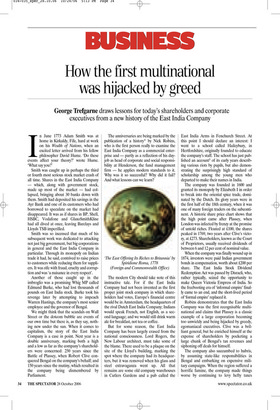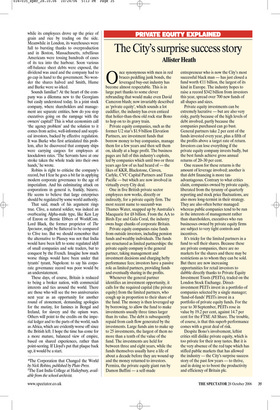How the first multinational was hijacked by greed
George Trefgarne draws lessons for today’s shareholders and corporate executives from a new history of the East India Company In June 1773 Adam Smith was at home in Kirkaldy, Fife, hard at work on his Wealth of Nations, when an excited letter arrived from his fellow philosopher David Hume. ‘Do these events affect your theory?’ wrote Hume. ‘What say you?’ Smith was caught up in perhaps the third or fourth most serious stock market crash of all time. Shares in the East India Company — which, along with government stock, made up most of the market — had collapsed, bringing about 30 banks down with them. Smith had deposited his savings in the Ayr Bank and one of its customers who had borrowed to speculate on the market had disappeared. It was as if shares in BP, Shell, HSBC, Vodafone and GlaxoSmithKline had all dived at once, leaving Barclays and Lloyds TSB imperilled.
Smith was so incensed that much of his subsequent work was dedicated to attacking not just big government, but big corporations in general and the East India Company in particular. Through its monopoly on Indian trade it had, he said, contrived to raise prices to customers while reducing them for suppliers. It was rife with fraud, cruelty and corruption and was ‘a nuisance in every respect’.
Another of those caught up in the imbroglio was a promising Whig MP called Edmund Burke, who had lost thousands of pounds on East India stock. Burke took his revenge later by attempting to impeach Warren Hastings, the company’s most senior employee and the governor of Bengal.
We might think that the scandals on Wall Street or the dotcom bubble are events of our own time but there is, as they say, nothing new under the sun. When it comes to capitalism, the story of the East India Company is a case in point. Next year is a double anniversary, marking both a high and a low as far as the company’s shareholders were concerned: 250 years since the Battle of Plassey, when Robert Clive conquered Bengal on the company’s behalf; and 150 years since the mutiny, which resulted in the company being dismembered by Parliament. The anniversaries are being marked by the publication of a history* by Nick Robins, who is the first person really to examine the East India Company as a commercial enterprise and — partly as a reflection of his dayjob as head of corporate and social responsibility at Henderson, the fund management firm — he applies modern standards to it. Why was it so successful? Why did it fail? And what lessons can we learn?
The modern City should take note of this instructive tale. For if the East India Company had not been invented as the first proper joint stock company in which shareholders had votes, Europe’s financial centre would be in Amsterdam, the headquarters of the rival Dutch East India Company; Indians would speak French, not English, as a second language; and we would still drink warm ale for breakfast, not tea or coffee.
But for some reason, the East India Company has been largely erased from the national consciousness. Lord Rogers, the New Labour architect, must take some of the blame. There used to be a plaque on the site of the Lloyd’s building, marking the spot where the company had its headquarters, but it was removed when his glass and steel extravaganza went up. All that remains are some old company warehouses in Cutlers Gardens and a pub called the East India Arms in Fenchurch Street. At this point I should declare an interest: I went to a school called Haileybury, in Hertfordshire, originally founded to educate the company’s staff. The school has just published an account† of its early years describing various riots by pupils, but also demonstrating the surprisingly high standard of scholarship among the young men who departed to make their names in India.
The company was founded in 1600 and granted its monopoly by Elizabeth I in order to break into the oriental spice trade, dominated by the Dutch. Its glory years were in the first half of the 18th century, when it was one of many foreign traders on the subcontinent. A historic share price chart shows that the high point came after Plassey, when London was infected by frenzy at the promise of untold riches. Floated at £100, the shares peaked in 1769, two years after Clive’s victory, at £273. Shareholders, known as the Court of Proprietors, usually received dividends of between 6 and 12 per cent of nominal value.
When the company was finally wound up in 1874, investors were paid Indian government bonds in compensation, worth about £200 per share. The East India Stock Dividend Redemption Act was passed by Disraeli, who, rather typically, seized the opportunity to make Queen Victoria Empress of India. So the freebooting era of ‘informal empire’ finally came to an end, and the short-lived period of ‘formal empire’ replaced it.
Robins demonstrates that the East India Company was the first recognisable multinational and claims that Plassey is a classic example of a large corporation becoming too unwieldy and being hijacked by greedy, egomaniacal executives. Clive was a brilliant general, but he enriched himself at the expense of shareholders by pocketing a large chunk of Bengal’s tax revenues and siphoning off deals for himself.
The company also succumbed to hubris, by assuming state-like responsibilities in Bengal and embarking on expensive military campaigns. When the region suffered a horrific famine, the company made things worse by continuing to levy hefty taxes while its employees drove up the price of grain and rice by trading on the side. Meanwhile in London, its warehouses were full to bursting thanks to overproduction and in Boston, Massachusetts, rebellious Americans were tossing hundreds of cases of its tea into the harbour. Soon various off-balance sheet debts were exposed, the dividend was axed and the company had to go cap in hand to the government. No wonder the shares halved and Smith, Hume and Burke were so irked.
Sounds familiar? At the heart of the company was a dilemma new to the Georgians but easily understood today. In a joint stock company, where shareholders and management are separate entities, how do you stop executives going on the rampage with the owners’ capital? This is what economists call ‘the agency problem’ and the solution to it comes from active, well-informed and sceptical investors, backed by effective regulation. It was Burke who first articulated this problem, after he discovered that company ships were carrying cargoes for employees at knockdown rates. ‘The Servants have at one stroke taken the whole trade into their own hands,’ he wrote.
Robins is right to criticise the company’s record, but I fear he goes a bit far in applying modern corporate governance to the age of imperialism. And his culminating attack on corporations in general is, frankly, bizarre. He seems to believe that large enterprises should be regulated by some world authority.
That said, much of his argument rings true. Clive, a natural soldier, was indeed an overbearing Alpha-male type, like Ken Lay of Enron or Bernie Ebbers of WorldCom. Lord Black, the former proprietor of The Spectator, might be flattered to be compared to Clive too. But we should remember that the alternative to Plassey was not that India would have been left to some regulated idyll of small companies and sole traders, but to conquest by the French. Imagine how much worse things would have been under that tyrants’ tyrant, Napoleon: to say his corporate governance record was poor would be an understatement.
These days, of course, Britain is reduced to being a broker nation, with commercial interests and ties around the world. There are those who will see the two anniversaries next year as an opportunity for another round of atonement, demanding apologies for the mutiny, for famines in Bengal and Ireland, for slavery and the opium wars. Others will point to the credits on the imperial ledger and to the parts of the world, such as Africa, which are evidently worse off since the British left. I hope the time has come for a more mature, balanced view of empire, based on shared experiences, rather than point-scoring. If Lloyd’s put that plaque back up, it would be a start.
*The Corporation that Changed the World by Nick Robins, published by Pluto Press. †The East India College at Haileybury, available from the school archivist.



























































































 Previous page
Previous page